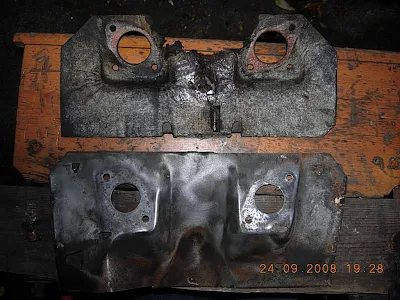Well finding the cylinder head was rather easy. It was in the shed all the time. Admittedly right at the bottom of the pile. So, since the MG had had a tool tidy up I moved it into there.
I had to move it ( stored in a handy large Poly-prop box from work ) several times in and out of the car every time I did things.
However, first job was to remove the thermostat housing. Two of the three nuts came away complete with studs, the third...........No chance. It appeared that the stud was slightly bent.
There was no way that was going anywhere. I did't want to drill it...........how anyway ?
A few gentle taps with the large and heavy Aluminiun faced hammer would certainly help.
Yes they did, the housing cracked from top to bottom. At first I didn't notice, I thought it was made in two separate parts, but no.....good old Fufferfour ruined it.
Still, once I realised this it was easy to remove. It still had the slightly bent stud left though.
This brings me to ask the obvious question.........................Why did motor manufacturers use so many studs ?....................They are horrible, always rust solid, break and are not easy to purchase.
The stud in question is about 35mm long ( 2 3/8" for the unenlightened) with a fine thread on one end ( 5/16 UNF) and coarse the other (5/16 UNC)..................................... FFS.........WHY ?
A simple 3/8" bolt , say BSW ..........or BSF, I don't mind ,would do + washer and hey ho.
Think how logical that would have been for good old BL, use 3/8 bolts all round, surely that would help keep the costs down for our struggling icon of manufacturing. But no, all different, hard to source and not cheap ( well not as cheap as 3/8" BSW/BSF anyway)
Removing the valve springs was a bit of a farce. All the manuals say you need a valve spring compressor. I'd priced them up, cheapest was £40 from Halfords. No way.
Thats almost a new doorskin !! After chopping a stout piece of 1.1/2" x 1.1/2" timber I found I could bear down on the spring cover and make the collet top loose. Trouble was it took both arms and my full weight of 10 stone.........................
porky alert............14 stone ( 190 Lbs )So I had no arms free..............except that wifey just happened to be passing by.
So she was roped into service with a screwdriver poking both halves of the collect out as I pressed down. It was approx 8.30 at night and she was tired. Needless to say she had to say it
" do you actually enjoy struggling without the correct tools,
getting cuts and scrapes on yor fingers and getting oily filthy all
over"
Well us guys all know the answer to that..........................and they don't, ..............obviously !!!!
After the third valve I developed a technique that made wifey redundant, but hurt like hell when the wooded bar slipped. But perseverence paid off and by 4.30 a.m I had them all out.
Only joking, it took about 30 mins of struggle, pain, sweat and swearing.
The valves, collets, caps and springs we all numbered, bagged and stored.
I cleaned the head face with trusty scraper tool.
Ground the inlet/exhaust chambers with drill/bobbly grindstone.
Then lapped valve seats.........................cor blimey, what a farce and faffin abaht !!!!!!
The tool resembles one of those Childs toy arrows sold with cheap seaside bows. In fact one of those might have been better. The idea is to insert the correct valve stem into correct hole, smear mating valve face with grinding paste, stick on rubber sucker end of stick and rub hands back and forth as if trying to light a fire. Simple in theory. I read the technique many times and never gave it a second thought as it sounded so easy.
Now three alarming things that they never tell you -:
a/. The paste does not stay put where you put it
b/. Your hands after about five "rubs" are way down the bottom of the stick.
c/. The rubber sucker gets paste all over it and makes it next to useless
At this rate I would finish one vale per year, its going to be a long resto !!!
So I devised the following plan.
The good old Bosch drill was working perfectly, it even has a lever handily placed, to reverse the rotation. And it does it without fuss and seamlessly.
Mounted stick thing in drill, cleaned sucker with ( don't laugh...........ink cartridge flusher)
drill 15 seconds clockwise, same anticlockwise x 5 and check seat.
I was looking for a nice even band of approx 2 to 3 mm around the valve and mating face.
Some steady back and forth with trusty Bosch and the valves were seated a treat.
Off to the boot ( trunk) of the trusty Toyota for a full soak and clean at the works in Slough next time I visit ( via Swavesy for a new thermostat housing..........next story )
Sorry no Photos..........:-(






